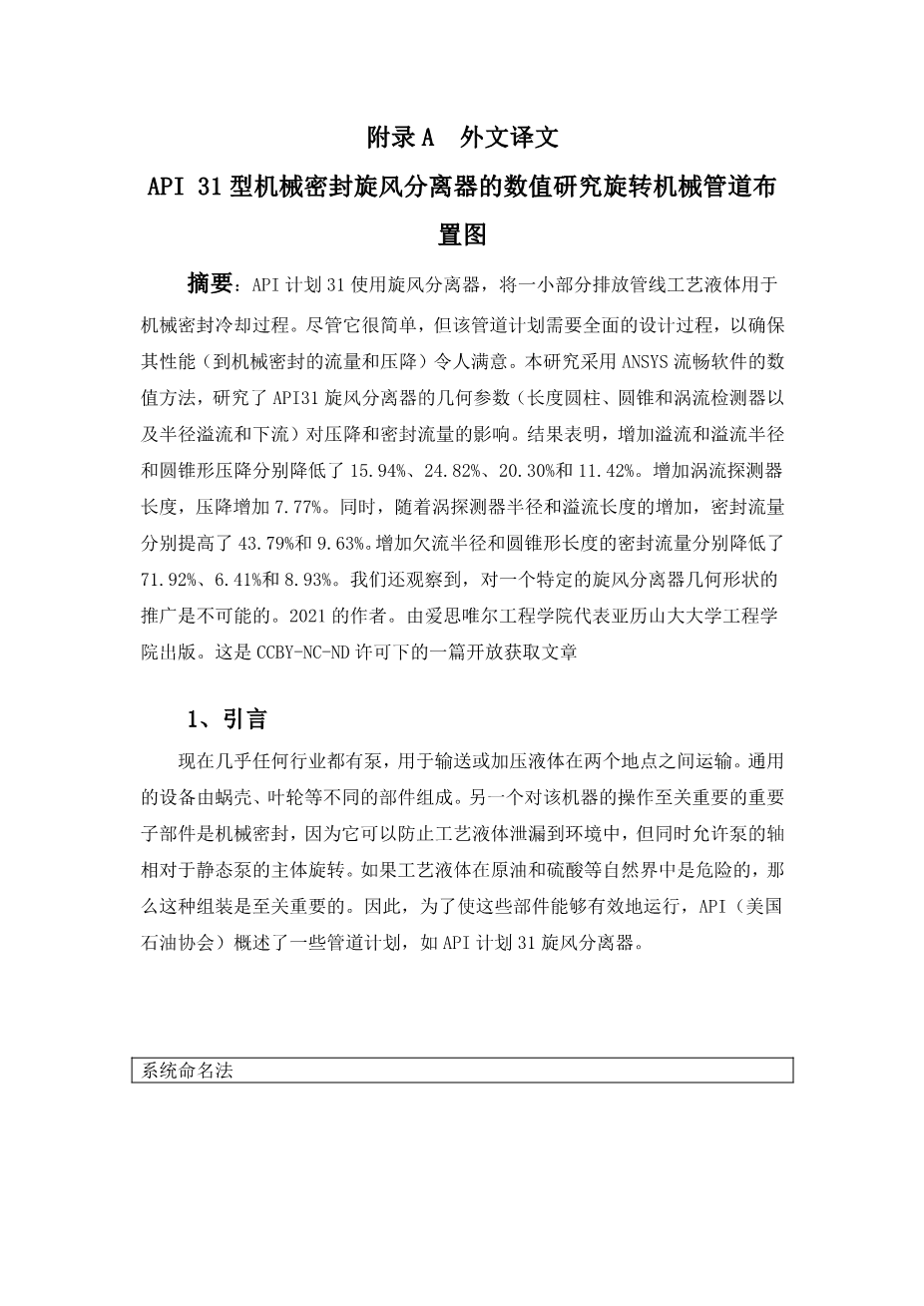API31型机械密封旋风分离器的数值研究旋转机械管道布置图外文翻译资料
2023-04-10 18:19:23
Numerical investigation of API 31 cyclone separator for mechanical seal piping plan for rotating machineries
Abstract
API plan 31 uses a cyclone separator that taps a small portion of discharge line process liquid for mechanical seal cooling process. Despite its simplicity, this piping plan requires comprehensive designing process to ensure its performances (flow rate to mechanical seal and pressure drop) are satisfactory. In this research, API 31 cyclone separator geometrical parameters (length cylinder, conical and vortex finder and radius overflow and underflow) effects onto pressure drop and seal flow rate are investigated using numerical method via ANSYS FLUENT software. It is found that increasing overflow and underflow radius and length of cylinder and conical decrease pressure drop by 15.94%, 24.82%, 20.30% and 11.42% respectively. Increasing vortex finder length meanwhile increases pressure drop by 7.77%. Meanwhile, increasing radius overflow and length of vortex finder increase flow rate to seal by 43.79% and 9.63% respectively. Increasing radius under-flow and length of cylinder and conical reduces flow rate to seal by 71.92%, 6.41% and 8.93% respectively. It is also observed that a generalization of a particular cyclone separator geometry is not always applicable as it depends on the cyclone separator base design itself where in this case all geometrical factors are significant to pressure drop and flow to seal.
1. Introduction
Pump exists in almost any industry nowadays to transfer or pressurized liquid for transport between two locations.The ubiquitous equipment consists of many different parts such as impeller, volute and shaft. Another important subcomponent that is vital to the operation of this machine is the mechanical seal as it prevents process liquid from escaping to the environment but simultaneously allows the pumprsquo;s shaft to rotate relative to the static pumprsquo;s body. Such assembly is crucial if the process liquid is hazardous in nature such as crude oil and sulphuric acid. Hence, to allow such component to operate efficiently, API (American Petroleum Institute) has outlined several piping plans such as API plan 31 cyclone separator.
Fig. 1 denotes the general cyclone separator body convention for discussion brevity where the z-axis along the cyclone separator axis is also shown. API 31 cyclone separator separates solid matter from pump discharge line process liquid to be flushed into mechanical seal chamber through cyclonersquo;s overflow exit point. It operates using centrifugal separation in which the unwanted solids are swirled to the separator wall for ejection back to the pump suction line (through underflow exit point) as shown in Fig. 2. Despite its simplicity, the flushing flow rate,fseal, must stay within a specific range in accordance to mechanical seal manufacturer. Insufficient amount will lead to overheating of seal faces and over flushing might disturb the flow profile in the mechanical seal. Moreover, the cyclone separator must not experience reverse flow where process liquid either at overflow or underflow is not exiting the separation device but instead completely moving in the opposite direction.
As cyclone separator is a passive device, it relies heavily onto the geometrical parameters in determining the pressure drop and flow deviation to the overflow and underflow. Vehmaanperauml; et al studied the effect of overflow and under-flow openings onto cyclone separator separation efficiency where it is found to be highly significant [1]. Chou et al investigated the effect of different vortex finder configuration on to flow bias to the overflow and underflow and proposed the optimized design [2]. Kyriakidis et al analysed different overflowunderflow ratio for efficiency and throughput ratio and found that specific ratio will yield optimal performance [3]. Meanwhile Song et al analysed different cyclone separator designs for separation efficiency and flow split effect [4]. It was reported that 90 blowdown angle yields the best performance for sewage application. Han et al explored different overflow and underflow alteration onto pressure drop [5]. Integrating an inner cylinder to the underflow exit port reduced pressure drop significantly without dearly affecting separation effi- ciency. It was also observed that pressure drop was reduced at shorter conical length. Also, Ji et al examined different inlet configurations to the flow field of a cyclone separator numerically and found that laminar spiral design increases cyclone separator performance remarkably [6]. In another paper, Jiang et al conducted numerical studies on separation efficiency and flow analysis on cyclone separator with adjustable inserts projecting into the underflow exit port. It was observed that the insert projection height behaves non-linearly against pressure drop. Salvador et al experimented with a new cyclone separator with filtering wall capability at the cylindrical and conical bodies [7]. The modification had allowed for separation effi- ciency improvement. In addition, Lee et al tested a small cyclone separator for low flow rate application using experi mental and numerical methods [8]. It was found that the increasing the flow rate or reducing the cyclone separator size can increase separation efficiency. Song et al added a conical surface to the axis of a cyclone separator and discovered it increased separation efficiency by 5% and reduces pressure drop [9]. Ullman et al numerically studied new cyclone separator design with longer vortex finder to improve separation effi- ciency and pressure drop [10]. Different cyclone separator separation chamber design was studied by Jiang et al where the conventional design still yielded the best performance over proposed designs in terms of flow profile, separation efficiency and pressure drop [11].
Fig. 2 API 31 cyclone separator operation taps minute disch
剩余内容已隐藏,支付完成后下载完整资料

英语译文共 36 页,剩余内容已隐藏,支付完成后下载完整资料
资料编号:[590121],资料为PDF文档或Word文档,PDF文档可免费转换为Word




